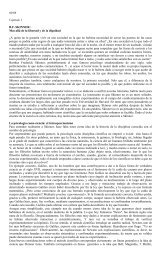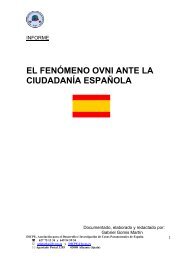The Word That is God
The Word That is God
The Word That is God
Create successful ePaper yourself
Turn your PDF publications into a flip-book with our unique Google optimized e-Paper software.
all th<strong>is</strong> <strong>is</strong> Om. Om <strong>is</strong> to be meditated on. W<strong>is</strong>hing to attain the supreme Self one utters [does<br />
japa of] Om; and he does indeed attain Brahman through that Om. <strong>The</strong> meaning of the<br />
passage <strong>is</strong> that, since the activities that are undertaken with the utterance of Om become<br />
fruitful, Om should be meditated on as Brahman.” (Shankara, Commentary on the Taittiriya<br />
Upan<strong>is</strong>had)<br />
“How should one perform devotion to the Lord, and what <strong>is</strong> the means of that devotion?<br />
To explain the form in which the devotee contemplates on Him, the sutra says: ‘H<strong>is</strong> designator<br />
[vachaka] <strong>is</strong> the Pranava [Om].’ Of the Lord Who has been described, the designating <strong>Word</strong> <strong>is</strong><br />
the Pranava.<br />
“<strong>The</strong> word Pranava <strong>is</strong> explained in the following way etymologically: pra stands for<br />
prakarshena: ‘perfectly;’ nu (from nava) means nuyate: ‘He <strong>is</strong> pra<strong>is</strong>ed.’ Thus Pranava, the<br />
word Om, pra<strong>is</strong>es (pranauti) the Lord. <strong>That</strong> <strong>is</strong>, the Lord <strong>is</strong> devoutly worshipped (pranidhiyate)<br />
through It by H<strong>is</strong> devotees. <strong>The</strong>y bow down (pranam) to Him through It. Through It they<br />
worship (pranidha) the Lord mentally; here the extra dha stands for the final [syllable] va of<br />
Pranava.<br />
“It <strong>is</strong> the Lord Who <strong>is</strong> expressed by the word Om; the sound of the <strong>Word</strong> accords with Its<br />
meaning.<br />
“From the termination ava <strong>is</strong> understood avati: ‘He favors.’ He brings out H<strong>is</strong> devotees<br />
from samsara, He leads those in samsara to nirvana, He brings to a devotee unsurpassed joy,<br />
He grants him samadhi to lead him to the highest truth. But all these meanings are associated<br />
with the most intense love of the Lord.<br />
“When the Lord <strong>is</strong> continuously worshipped in the mind by means of th<strong>is</strong> syllable, Om, He<br />
gives H<strong>is</strong> grace. <strong>The</strong>re are many sacred texts indicating that Om <strong>is</strong> Brahman.<br />
“<strong>The</strong> relationship between Brahman and Om <strong>is</strong> that of a lamp and its light. …Th<strong>is</strong> <strong>is</strong> the<br />
relationship between the Lord Who <strong>is</strong> expressed and the Pranava which expresses Him.<br />
“Through Om the Lord <strong>is</strong> met face to face.<br />
“It <strong>is</strong> proper to employ Om as a means for practicing worship of <strong>God</strong>.<br />
“When the yogi has understood the identity of Om and Brahman he attracts the grace of<br />
the supreme Lord through Its japa and bhavanam. Bhavanam <strong>is</strong> setting the heart on the Lord<br />
Who <strong>is</strong> designated by Om and brought into the mind by It. Yog<strong>is</strong> who are engaged in both japa<br />
and bhavanam attain one-pointedness of mind. After japa, which causes h<strong>is</strong> mind to bow<br />
before the Lord, let him engage in bhavanam. When h<strong>is</strong> mind becomes unwavering from<br />
bhavanam on the Lord, let him do japa of Om, for japa leads to bhavanam. When japa and<br />
bhavanam of Om come to perfection then the Supreme Lord (Parameshwara), the Supreme<br />
Self (Paramatman) Who stands in the highest place shines forth for the yogi.<br />
“Om <strong>is</strong> the Name of the Supreme Lord.” (Shankara, Commentary on the Yoga Sutras)<br />
“Salutations to Dakshinamurti, 81 Who <strong>is</strong> pure and calm, the embodiment of pure knowledge<br />
and Who <strong>is</strong> attainable through the syllable Om.” (Hymn to Dakshinamurti)<br />
By means of Om we can align ourselves with Him Who <strong>is</strong> the true Guru of all sentient<br />
beings and receive H<strong>is</strong> direct guidance.<br />
81 Dakshinamurti: A name for Lord Shiva as the silent teacher. Vedic Religion declares that in every cycle of creation <strong>God</strong><br />
manifests as Dakshinamurti and becomes the guru of the first human beings–those who were most spiritually evolved in the<br />
previous creation–teaching them the path to liberation (moksha).<br />
83
















